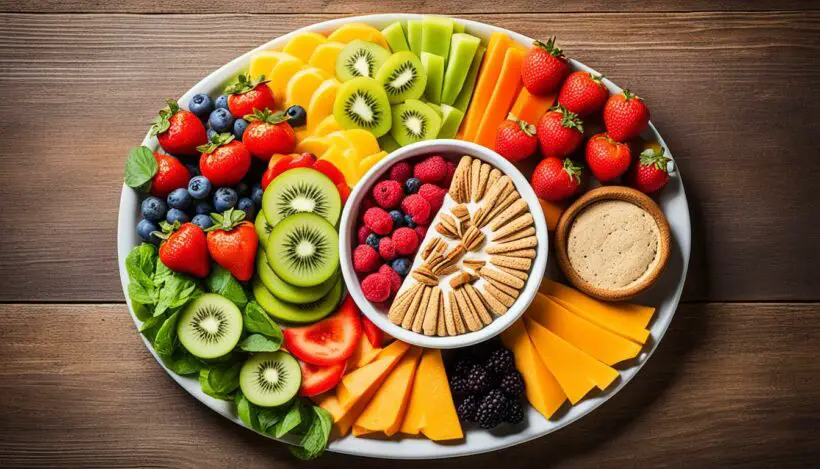When it comes to eating healthfully, it’s common to think that sweets and treats have no place in a balanced diet. However, experts say that occasional indulgences can actually be part of a healthy eating plan. That’s right – you can enjoy special splurges and occasional rewards without guilt.
So, how can you strike a balance between your desire for occasional sweets and the need to maintain a nutritious diet? The key is moderation and making smarter choices.
Instead of completely cutting out occasional luxuries, you can control portion sizes and choose treats that offer some nutritional benefits. Opt for treats with 100 to 200 calories and consider incorporating fruits as a healthy dessert option. By limiting the variety of treats you keep at home and even making homemade versions, you can trim down the fat, calories, and sugar content.
Remember, it’s all about finding the right balance. Enjoying occasional treats in moderation can actually contribute to your overall well-being and satisfaction with your diet.
Incorporating Treats into a Healthy Diet
Treats are an important part of a balanced diet and can be enjoyed occasionally without derailing a healthy eating plan. It is essential to understand that indulgence is a normal part of health and that treats can be included in a well-rounded diet. Labeling foods as “good” or “bad” can lead to restrictive eating behaviors and ultimately, overindulgence. By allowing yourself to enjoy treats in moderation and without guilt, you can maintain a healthy relationship with food. Treats should be incorporated consciously and mindfully into your diet, based on your personal preferences and goals.
When incorporating treats, it’s important to find a balance that works for you. Rather than completely eliminating these indulgences, consider how you can fit them into your overall eating plan. By incorporating treats into your diet, you can satisfy your cravings and enjoy the occasional splurge while still maintaining a balanced diet.
One way to incorporate treats is to plan for them. Instead of viewing treats as something to be avoided, incorporate them into your meal planning. For example, if you’re craving a sweet treat, try including it as part of your dessert after a balanced and nutritious meal.
Another approach is to choose healthier options for your treats. Instead of reaching for a calorie-laden sugary snack, opt for a piece of fruit or a small portion of dark chocolate. These alternatives can satisfy your cravings while also providing some nutritional benefits.
It’s also important to be mindful of portion sizes when enjoying treats. Remember that indulging occasionally doesn’t mean overindulging. Enjoy your treats in moderation and practice portion control to ensure you’re not consuming excessive calories or derailing your healthy eating goals.
Image: Incorporating Treats
The Role of Treats in Health
Indulgence and treats play an essential role in overall health and well-being. While the primary function of food is to provide nourishment to the body, there are moments when food is also consumed for its pleasurable aspects and to support emotional and psychological health.
Treats are part of a balanced diet and should not be seen as completely separate from a healthy eating plan. They can be enjoyed consciously and in moderation to provide both physical and mental satisfaction. By including treats in your diet, you can experience the pleasure of occasional indulgence without compromising your overall health.
Labeling treats as “bad” can lead to negative emotions and unhealthy eating behaviors. It’s important to adopt a balanced perspective and embrace the nourishing and pleasurable aspects of treats. By doing so, you can enhance your psychological well-being and maintain a positive relationship with food.
Understanding Treats in a Healthy Diet
Treats, also known as discretionary foods, are often high in sugar, salt, and saturated fat. While they do not provide significant nutritional benefits, they can still be enjoyed in moderation as part of a healthy eating plan. It is important to understand what moderation means and to be mindful of portion sizes.
Treats should not comprise a large portion of daily food intake and should be balanced with nutrient-dense foods. By making smart choices and limiting the frequency and quantity of treats consumed, they can be incorporated into a healthy diet without derailing progress or causing weight gain.
- Choose treats that offer a combination of taste and nutritional value.
- Opt for smaller portion sizes to satisfy cravings without excess.
- Balance treats with nutrient-dense foods like fruits, vegetables, lean proteins, and whole grains.
- Avoid excessive consumption of empty calories found in treats.
By being mindful of your treat consumption and maintaining moderation, you can still enjoy occasional indulgences while staying on track with your healthy eating goals.
Managing Cravings and Overeating
If you find yourself craving treats, it’s important to take a moment and assess whether you’re truly hungry or if the craving is being driven by other factors such as boredom or emotions. Pausing and questioning your hunger signals can help you gain control over your cravings.
Mindful eating is another effective strategy for managing cravings and overeating. By practicing mindfulness, you can become more aware of your body’s hunger signals and eating patterns. This can help you make healthier choices and prevent overindulgence.
When it comes to satisfying your cravings, choosing healthier options is key. Instead of reaching for sugary or high-calorie treats, opt for alternatives that are lower in sugar and calories. This could include fresh fruit, yogurt, or a small piece of dark chocolate.
Portion control is also important for managing cravings and preventing overeating. Instead of mindlessly devouring a large portion of treats, try to control your portion sizes. Enjoy a small serving of your favorite treat and savor every bite.

Additionally, it’s crucial to base your main meals around lean proteins, whole grains, and plenty of vegetables. These nutrient-dense foods will provide your body with the necessary fuel and help keep you satisfied, reducing the likelihood of cravings or overeating.
One more helpful tip is to keep nutritious snacks readily available. By having healthy choices on hand, you can curb sudden cravings or the temptation to indulge in unhealthy snacks. Options like sliced vegetables, nuts, or yogurt are great alternatives to high-calorie treats.
By practicing craving control, portion control, mindful eating, and making healthy choices, you can successfully manage your cravings and prevent overeating. Remember, moderation is key, and indulging in treats occasionally can be a part of a balanced and healthy lifestyle.
The Importance of Moderation
The number of discretionary food serves you can have each day depends on factors such as weight, height, and physical activity level. Most individuals in the healthy weight range with a moderate activity level can enjoy one or two serves of treat foods per day. Those who are taller, have a more active job, and are at a healthy weight may be able to include up to three serves of treat foods per day. It is important to find a balance that works for your individual needs and goals to maintain a healthy eating plan.
Making Smarter Choices
When it comes to incorporating treats into your diet, it’s important to prioritize making smart choices. By selecting treat food options that provide nutritional value and have lower calorie content, you can indulge without compromising your health goals. A great way to do this is by reading nutrition labels and opting for treats that contain fiber, calcium, and whole grains.
Instead of reaching for high-fat and sugar-loaded treats, consider choosing baked options, low-fat alternatives, or treats made with dark chocolate, nuts, or dried fruit. Not only do these alternatives offer added nutrients, but they also satisfy your cravings while reducing temptation. Furthermore, limiting the variety of treat options can help you make healthier choices and stay on track.
Another great option is to explore homemade versions of your favorite treats. By making treats at home, you have more control over the ingredients, allowing you to decrease fat, calories, and sugar content. This way, you can enjoy your treats guilt-free while still maintaining a balanced diet.
Smart Choices for Treat Foods:
- Whole grain cookies or crackers
- Low-calorie ice cream or frozen yogurt
- Dark chocolate-covered nuts or dried fruit
- Baked chips or popcorn
- Low-fat pudding or yogurt
By incorporating these smarter choices into your treat options, you can enjoy indulgence in moderation while still prioritizing your nutritional needs.
Curb Cravings and Enjoy Treats Mindfully
Cravings for treat foods can be controlled by understanding the true nature of your hunger. Before giving in to those cravings, take a moment to assess whether you are genuinely hungry or if the desire is driven by other factors such as boredom or emotions. By listening to your body and understanding its needs, you can make more mindful choices.
To prevent excessive cravings, it’s important to keep healthy options readily available. Stock your pantry and fridge with nutritious foods that can satisfy hunger and provide the nutrients your body needs. This can help curb cravings and prevent you from reaching for less healthy treats.
When you do indulge in treats, it’s essential to savor each bite and pay attention to your taste preferences. Mindful eating allows you to truly enjoy and appreciate the flavors and textures of the food you’re consuming. By slowing down and being present in the moment, you can fully experience the pleasure of the treat.
Portion control is another important aspect of enjoying treats without overeating. By practicing portion control, you can ensure that you’re consuming a balanced intake of nutrients while still enjoying your favorite treats. It’s helpful to serve yourself a small portion and savor each bite, rather than mindlessly indulging in a larger quantity.
Remember, moderation is key. By approaching treats with mindfulness and moderation, you can satisfy your cravings without derailing your healthy eating plan. It’s all about finding a balance that allows you to enjoy treats in a way that aligns with your overall goals and preferences.
Conclusion
When it comes to maintaining a healthy diet, finding the right balance is key. And that includes incorporating occasional treats into your eating plan. The good news is that enjoying treat foods can be done in a mindful and moderate way, without compromising your progress or feeling guilty.
By making smart choices and being mindful of portion sizes, you can indulge in your favorite treat foods without derailing your healthy eating goals. It’s all about understanding that treats can be a part of a balanced diet and embracing them as moments of indulgence and pleasure.
Remember, moderation is crucial. Listening to your body’s hunger signals and being conscious of what you’re eating will help you find that balance. Treats should be enjoyed in moderation, alongside nutrient-dense foods, to ensure you’re nourishing your body while satisfying your taste preferences.
So, go ahead and enjoy your occasional indulgences. Treat yourself to your favorite treat foods, guilt-free. Just remember to incorporate them into your diet mindfully, make healthier choices, and savor each bite. By maintaining a healthy relationship with treats, you can live a balanced lifestyle and nourish your body while satisfying your cravings – all in moderation.






